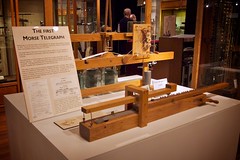Interdisciplinary connections
By Mary Bigelow
Posted on 2013-08-06
 Our middle school teams are encouraged to make interdisciplinary connections. I have some ideas for integrating physical science topics with language arts and mathematics, but we’re struggling with social studies connections. I was considering having students do presentations or pamphlets on inventors, but do you have any other ideas?
Our middle school teams are encouraged to make interdisciplinary connections. I have some ideas for integrating physical science topics with language arts and mathematics, but we’re struggling with social studies connections. I was considering having students do presentations or pamphlets on inventors, but do you have any other ideas?
—Casey, Montgomery, Alabama
Inventions and inventors could be an interesting topic for students. If your learning goals focus on students’ finding and summarizing information, then the presentations of biographies could be appropriate. However, I hope in the context of STEM education and the engineering focus of the Next Generation Science Standards you’ll want students to also understand and have experiences with the processes of inventing and innovating, perhaps addressing the topic “How do we invent inventors?”
I observed a social studies teacher introducing a unit on the Industrial Revolution. He framed the unit around two questions: Why do we invent or innovate? How do some inventions and innovations change society? At the start of the lesson, he demonstrated Morse code and had students tap out messages. They then discussed communications inventions of the 19th century (such as the telegraph and telephone) compared with communications today such as cell phones and texting, with which the students readily identified. He also asked “Imagine that the light bulb had never been invented. How would our world be different today?” The conversations in this classroom were amazing, as students were hooked into the topic.
This set the stage for a unit he had designed to show how the Industrial Revolution changed America from an agricultural to an industrial economy, from a rural to an urban society, and to a nation with even more immigrants. I wished I could have stayed for the entire unit!
As I thought about this social studies unit, I could see ways to integrate the topic with science and engineering topics.
Rather than a stand-alone activity on inventions, perhaps you could use inventions and innovations as an over-arching theme or big idea for a series of units in physical science. Topics such as mechanical forces and simple machines, motion, electricity and magnetism, light and sound waves could be investigated in the context of inventions. Students could engage in building things in class, taking things apart to see how they work, designing solutions to problems, and working with robotics and other electronics.
As a culminating project, students could become inventors themselves, finding a problem, designing and testing an invention to solve the problem, and “selling” their invention to others. This would take more planning than having students write reports, but NSTA journals have published many articles showing young classroom inventors and “invention conventions.” I’ve created a resource collection with articles from NSTA journals and NSTA Reports on Inventions and Inventors.
The NSTA website also has information on national initiatives such as the Toshiba/NSTA ExploraVision science competition. The NSTA website also has a calendar of Science Education Events and Programs with projects that may be of interest. NSTA and SciStarter are partnering to connect teachers and their students to collaborative opportunities with scientists on cutting-edge research projects and informal science activities.
If you’re not sure your students can do this, think about a high school student who recently created a new type of cell phone charger to solve the problem of her dead battery!
Photo: http://www.flickr.com/photos/miss604/8106003398/
Disclaimer: The views expressed in this blog post are those of the author(s) and do not necessarily reflect the official position of the National Science Teaching Association (NSTA).


